Motor from a washing machine to a bicycle
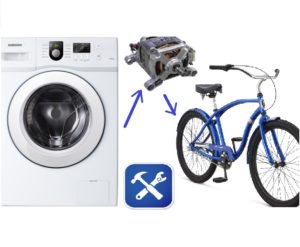 Among the unusual uses of a washing machine engine, the most unusual can be considered turning it into a bicycle motor. A bicycle motor from a washing machine sounds more than extravagant, but looks absolutely exceptional. Read about whether it is possible to produce this “technical artifact” and how to do it in this publication. We warn you right away that the project is technically complex and quite expensive, so if you are not confident in your abilities, it is better not to start.
Among the unusual uses of a washing machine engine, the most unusual can be considered turning it into a bicycle motor. A bicycle motor from a washing machine sounds more than extravagant, but looks absolutely exceptional. Read about whether it is possible to produce this “technical artifact” and how to do it in this publication. We warn you right away that the project is technically complex and quite expensive, so if you are not confident in your abilities, it is better not to start.
Drive mechanism
Before you start converting a regular bicycle into an electric bicycle, take a look at the technical potential of your iron horse. The bicycle must have a fairly powerful frame, since it must, at a minimum, support the weight of the rider and the weight of the equipment that will be installed on it. If everything is in order with this, you can begin to remake the bicycle and install on it the motor from the washing machine, drive mechanism, control system and power supplies.
Let's start by designing and installing the drive mechanism parts. Let us note right away that in order to make a homemade electric bicycle from the engine of an old washing machine, we will need a full-fledged metalworking workshop. Well, or at least a lathe, drilling machine, welding machine, as well as an impressive set of materials and tools, including a fairly spacious room where you can conduct experiments.
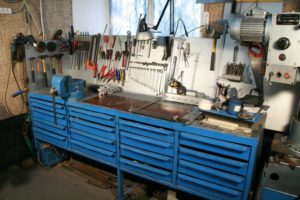 The drive mechanism will consist of the following elements:
The drive mechanism will consist of the following elements:
- modified bicycle hub;
- large pulley;
- drive belt from the washing machine;
- small engine pulley
- motor shaft.
The most difficult thing here, perhaps, is making a large pulley. It’s almost impossible to find a standard part that fits the size, so you’ll have to make one.
- From a steel sheet (2 mm), cut out a perfect circle.
The recommended pulley diameter is 22 cm, but if the lathe can cut a circle with a larger diameter, then do more, the more reliable the drive mechanism will be.
- We drill small holes in the hub of the rear bicycle wheel, between the spokes. We drill similarly located holes in the steel circle.

- We drill large holes along the edges of the steel circle, simply in order to reduce the weight of the part. Because, as noted above, all the equipment together with the rider will weigh a lot, and you need to unload the bicycle frame as much as possible, saving at least a few kilograms.
- Next is the crucial moment: it is necessary to weld a 20x4 mm steel strip to the edge of the disk. You need to weld gradually by bending the strip of metal exactly along the edge. This is not the easiest thing, because the welded joint must be perfectly smooth.
- After this, we load the part into a lathe and process it again, removing all the irregularities and roughness.
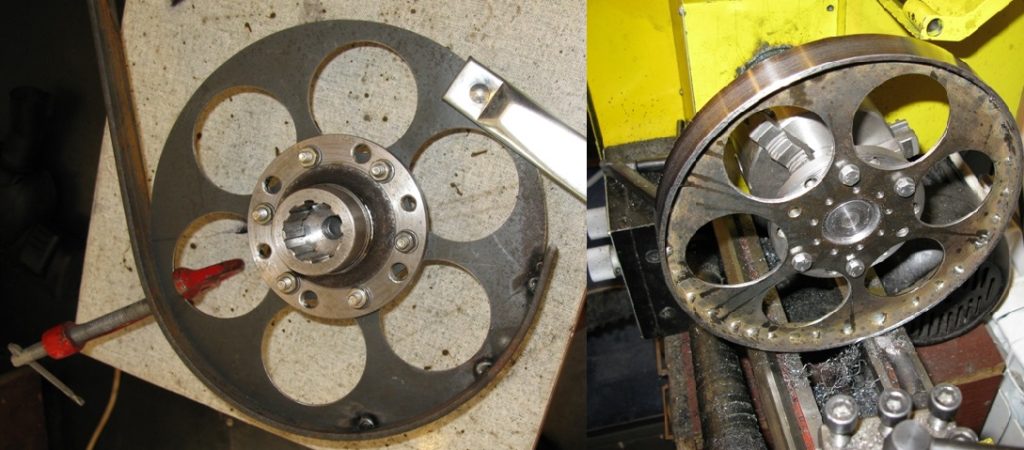
- So our part has turned into a full-fledged pulley. Now all we have to do is paint the main part of the drive mechanism and screw it to the rear bicycle wheel.
Important! The thickness of the large pulley will not allow the bicycle wheel to rotate after installation, since the part will touch the frame. It is necessary to either bend the frame or modify it in some other way, depending on the design of the bike.
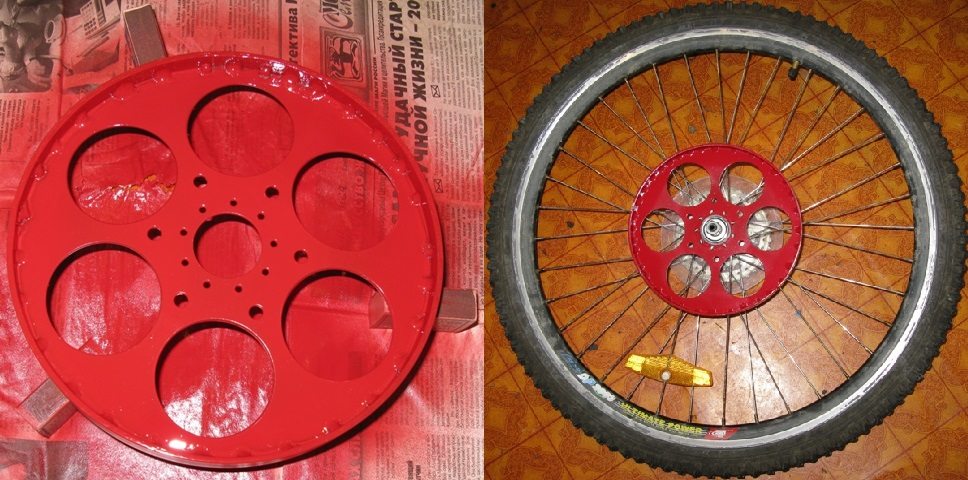
Frame modification
We made a large pulley and adapted the remaining parts of the drive mechanism. By the way, there is no need to redo the remaining parts of the drive mechanism.A small pulley is already on the motor shaft from the washing machine, there is also a drive belt, so we can move on to remaking the bicycle frame with a clear conscience. When modifying the frame for a new electric bicycle, we must take into account that the engine on it should be positioned as rigidly as possible. To do this we do the following.
- If the bicycle has a standard rack, we weld additional transverse tubes to it to strengthen the structure.
- If a trunk is not provided, then you need to weld a mount for the engine from pipes, reminiscent of what is shown in the figure below.
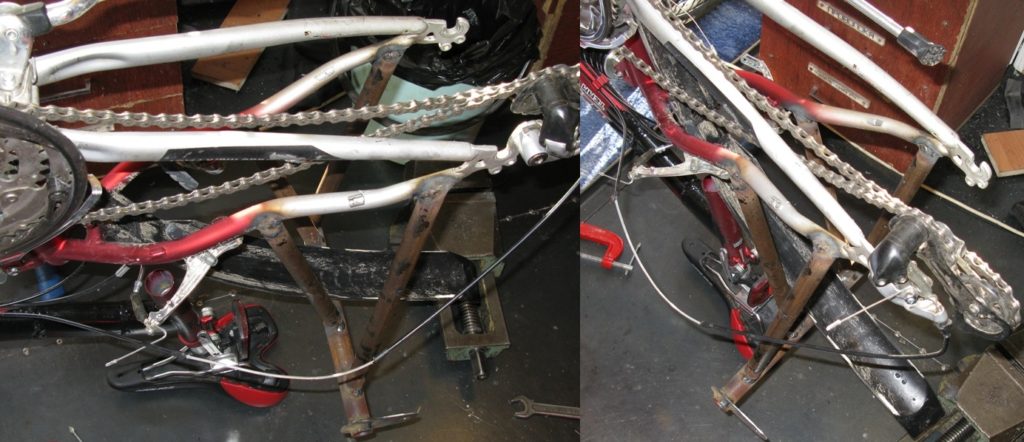
- New frame parts need to be sanded, painted and dried.
Attention! When welding the frame for the engine, take into account the height of its seat. It is necessary that the distance between the small pulley of the engine and the large pulley of the bicycle wheel is ideal for tensioning the belt.
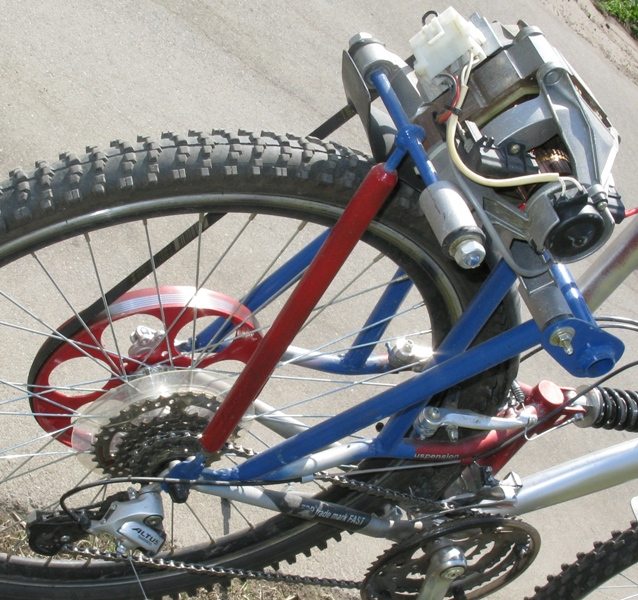
We continue to assemble the electric bike. We install the engine on the frame, install the rear wheel with the pulley screwed on, and check the rotation of the wheel. We tighten the drive belt, give small turns by hand, checking that it does not jump off. If everything is fine, we begin to connect the washing machine motor and organize its autonomous power supply.
Motor power supply
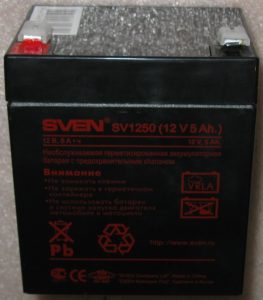 About, how to connect the motor from a washing machineWe wrote and spoke repeatedly to make it work. So we will not focus on this issue again, but will move straight to the organization of autonomous power supply for our commutator motor. Otherwise, our homemade electric bicycle will continue to be driven by the muscular power of the legs.
About, how to connect the motor from a washing machineWe wrote and spoke repeatedly to make it work. So we will not focus on this issue again, but will move straight to the organization of autonomous power supply for our commutator motor. Otherwise, our homemade electric bicycle will continue to be driven by the muscular power of the legs.
First, let's figure out whether a commutator motor from a washing machine can operate on direct current? After all, the batteries, which will become the main source of power for the electric bicycle motor, provide direct current, and the washing machine and its units operate from an alternating current network (household network 220V). It turns out there are no problems with this, moreover, the motor from the washing machine works much better on direct current than on alternating current, which, naturally, is to our advantage.
We will select suitable batteries. This may be difficult, since we will need several rather massive batteries, which are difficult to mount on a bicycle due to their size and heavy weight. The best option is eight compact 12-volt motorcycle batteries, which together produce a voltage of 96V. But there is a problem - even such batteries take up a lot of space and, in total, weigh quite a lot, and it is not clear how to place them on the frame of an electric bicycle.
After much thought and a whole series of unsuccessful experiments with battery boxes, it was decided to distribute the batteries evenly throughout the frame, hanging the electric bike with them like a Christmas tree with toys.
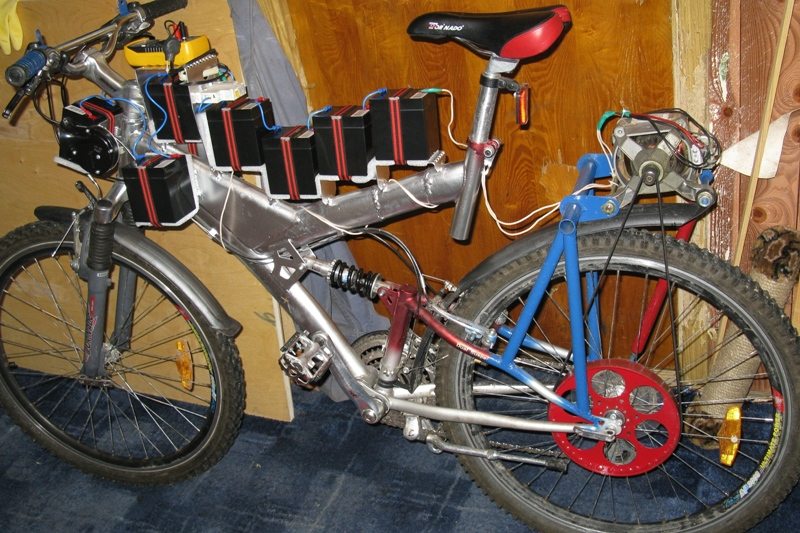
This technical solution added problems.
- Firstly, as you can see in the picture above, the bicycle frame had to be strengthened once again so that it could withstand the additional load. This, unfortunately, led to the weight of the “iron horse” once again increasing, but nothing can be done about it.
- Secondly, 8 separate battery mounts had to be welded to the frame so that they could be securely fastened.
- Thirdly, we had to literally cover the entire frame with wires to connect the batteries to each other and to the engine.
- And fourthly, we had to once again improve the aesthetics by repainting the bike frame almost completely.
Control block
There are still a number of technical difficulties that we have not yet considered - how to control the engine speed, how to prevent the current from rising to the limit values when starting the electric bike and during its acceleration, and, finally, how to monitor the charge of the batteries while driving. The electric bicycle control unit, which we need to assemble, will help resolve these difficulties. We will need:
- 32.5 kHz switching downconverter.
- Variable resistor.
- Microcontroller ATtiny26.
- Measuring resistor.
- Chip IR2127S.
- Three power transistors type IRFB33N15D.
- Three diodes type 10CTQ150.
- Charging from a mobile phone.
- DC-DC converter P6AU-1215ELF.
- Red and green LEDs.
- Automatic 6A.
- Plastic case of suitable dimensions.
- Metal radiator from a computer motherboard.
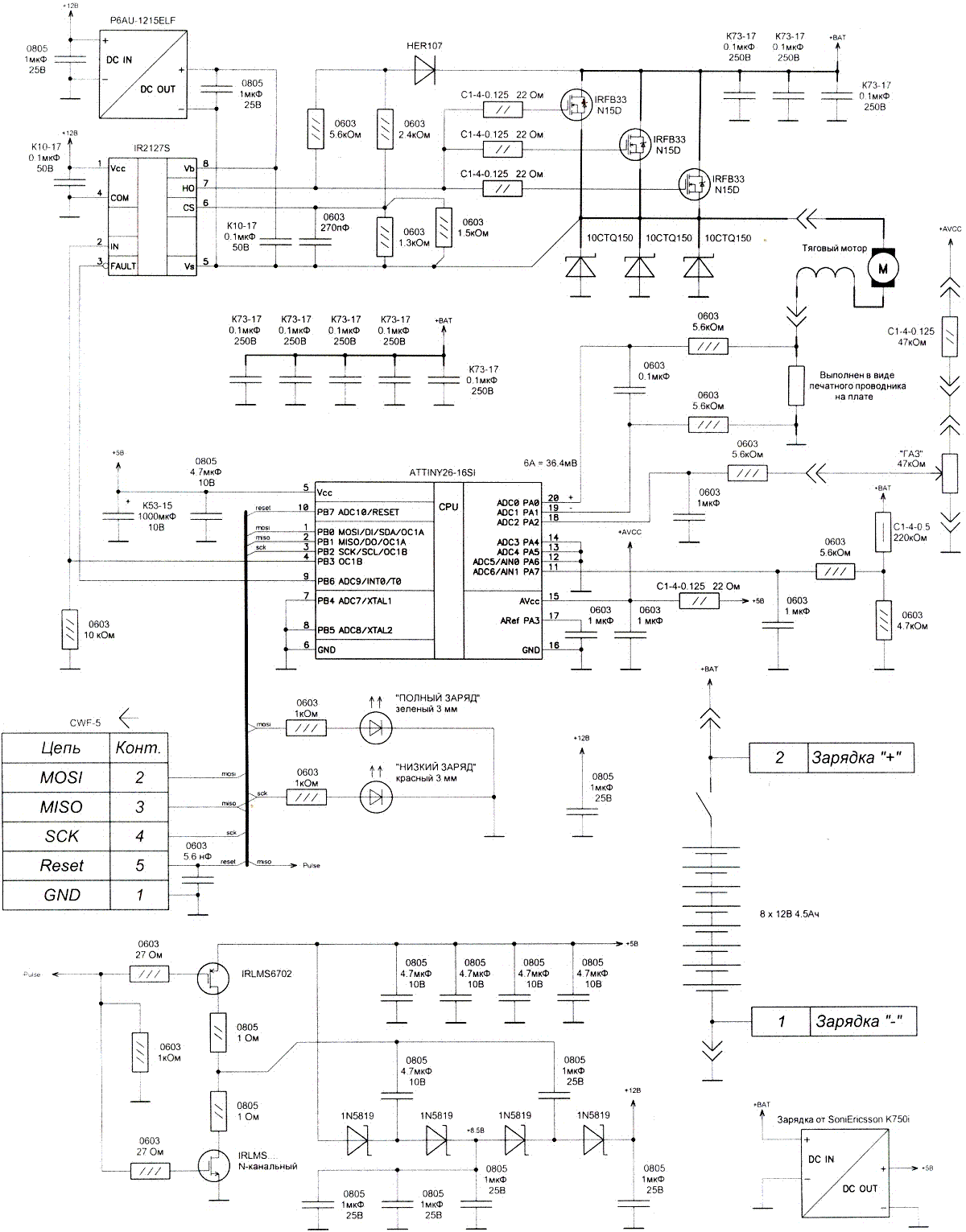
We will not describe the process of assembling the control module, and there is no need for this, since all the necessary information is presented in the diagram above. You just need to read this diagram, understand it and reproduce it on several printed circuit boards. The result should be something similar.
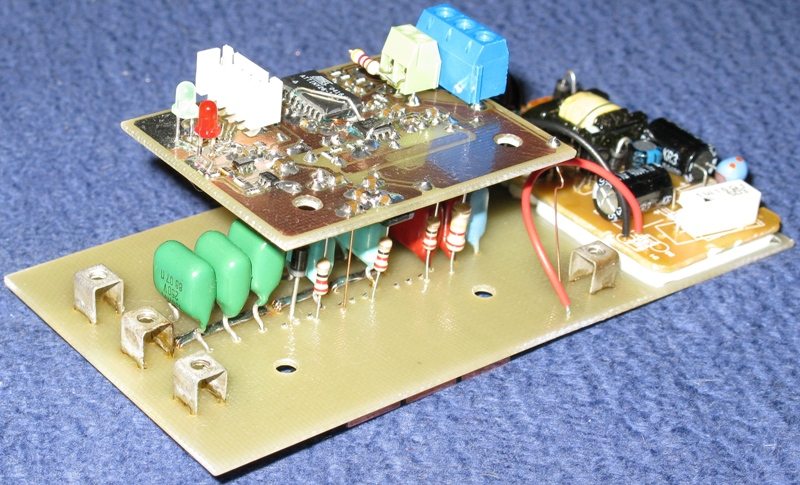
The board must be placed in a compact waterproof plastic case, with a radiator screwed to the bottom.
We did not find a suitable housing for the module, so we had to use what we had. In order for the control module to start working, you need to turn on the machine, turn the “gas handle,” that is, a variable resistor mounted on the handlebars of the electric bicycle. After which the engine will begin to smoothly gain speed, and the green LED on the module will light up.

If the batteries are completely discharged or their capacity is insufficient, the red LED will light up, after which the circuit will be de-energized after a few seconds. You will have to travel on your own until you can recharge the batteries.
Tests and their results
The time has come to test the “infernal machine” on which so much time, labor and money have been spent. We approached the tests no less scrupulously than when making a homemade electric bicycle and carried them out in three stages:
- Driving on an ordinary relatively flat road (half asphalt, half dirt road) at a speed of 18 km/h.
- Driving on smooth asphalt with slight ups and downs at a speed of 25 km/h.
- Driving at maximum speed on smooth asphalt without ups or downs.
As a result, in the first case, accelerating to 18 km/h and maintaining this speed, we were able to drive 27 km on a single battery charge on dirt roads and broken asphalt. The muscular strength of the legs was practically not used. There were no ups or downs along the way.

Having ridden an electric bicycle on flat asphalt with slight descents and ascents at a speed of 25 km/h, we managed to set a record of 19 km on a single battery charge. ANDFinally, maximum speed tests showed that our homemade electric bicycle can accelerate to 30-35 km/h, this, of course, is on smooth asphalt, without descents or ascents.
For your information! The weight of the rider testing the bike was 96 kg.
It is noteworthy that if we help the engine by rotating the pedals, we can relatively easily reach a maximum speed of 45-50 km/h, and if we try, we can reach 60 km/h. At the same time, the batteries discharge faster, after about 10-15 km of such a sprint.
In conclusion, we note that to make an electric bicycle from a washing machine engine yourself, you will need at least several months, a workshop, a lot of strength and patience, as well as money. By the way, we spent about $700 on the project, provided that we did not have to purchase a bicycle and parts of an old washing machine. If you are determined to make your own electric bike, go for it, we can only wish you good luck!
Interesting:
12 reader comments
Add a comment Cancel reply
Categories
Washing machine repair


For buyers

For users

Dishwasher


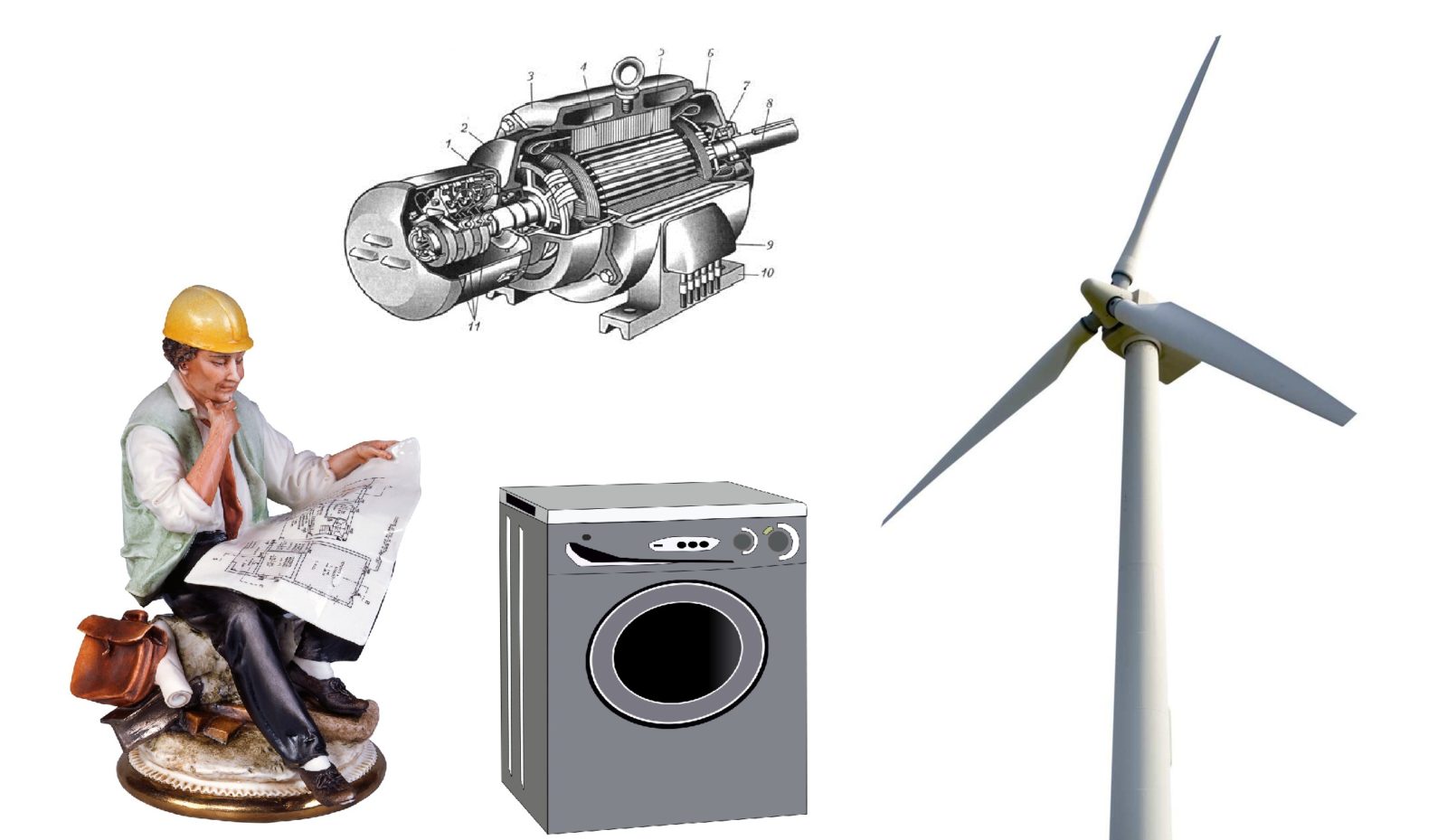
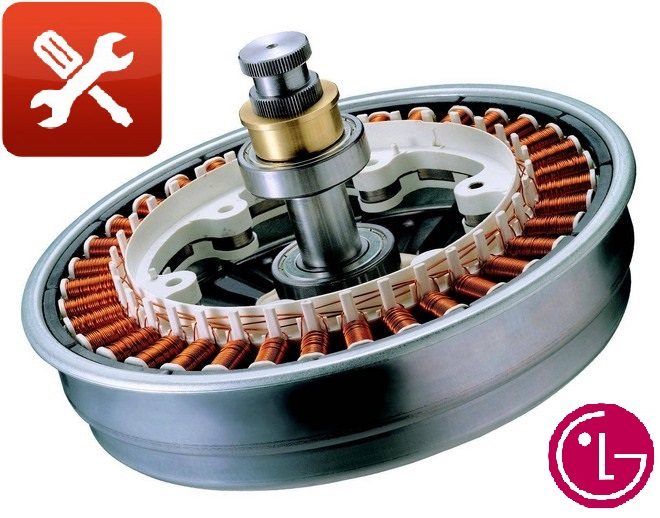

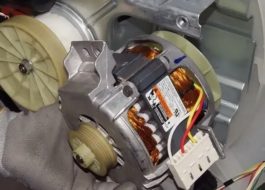
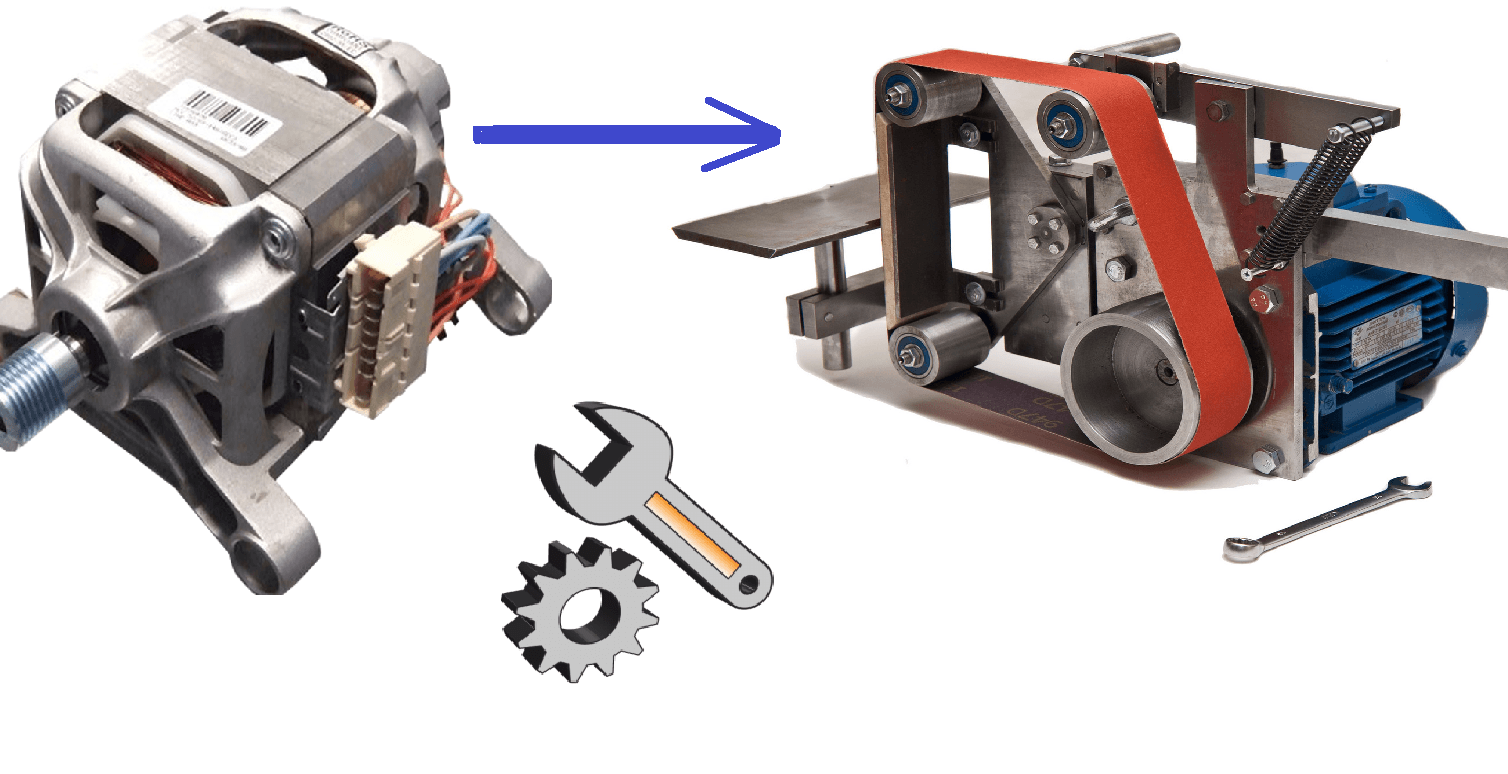










So what was the $700 spent on then?
With such a weight, wouldn’t it be easier to install a compact gasoline-powered generator, squeeze out all the power of the engine, and put the brains in the washing machine.
It’s easier to install a chainsaw engine, for example, rather than a generator.
For 700 bucks you can buy a motor wheel with all the accessories, it will even be cheaper.
On the contrary, a large pulley should be placed on the engine, and a small one on the wheel.
If you do this, the engine will run under load
What a horror. For that kind of money, it’s easier to buy a ready-made wheel motor, and eight batteries cost a lot.
In fact, such things are done for the soul. The author ruined the bike because he wanted creativity.But in my opinion, it is better to take lithium-ion batteries. You can place them in a tube like AA batteries and raise the voltage to 170 volts. At the same time, the watt/hour value will also increase. Also enlarge the pulley for the rear wheel, or use a grinder. It has a gearbox and the same type of engine. It will also spin from direct current. Only the regulator does not use a current stabilizer, but PWM. This will avoid current losses due to heating of the key element. But in general, I think the author proceeded from what was available. By the way, the drive can be made on the front wheel, so as not to disfigure the rear. And install the overrunning clutch in the area of the wheel hub to avoid mechanical losses.
Simpler - 12 volt battery - 220 volt inverter - engine - additional circuits - ready.
Why not use lithium batteries?
It’s even easier not to hang all this crap on the bike, but to use the muscular strength of your legs. Then the mileage is limited only by the presence of alcohol to maintain tone and relieve stress from high speeds.
And a trailer with a refrigerator for snacks.